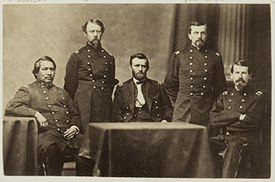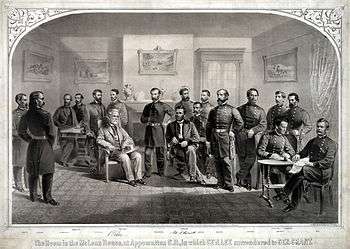Ely S. Parker
| Ely S. Parker | |
|---|---|
 | |
| Birth name | Ely Samuel Parker |
| Born |
1828 Indian Falls, New York |
| Died |
August 31, 1895 (aged 66–67) Fairfield, Connecticut |
| Buried at | Forest Lawn Cemetery, Buffalo, New York |
| Allegiance | United States of America |
| Service/branch |
United States Army Union Army |
| Years of service | 1863–1869[1] |
| Rank |
|
| Unit |
Western Theater Adjutant to General Grant |
| Battles/wars | |
| Other work | Head of the Bureau of Indian Affairs |
Ely Samuel Parker (1828 – August 31, 1895), (born Hasanoanda, later known as Donehogawa) was a Seneca attorney, engineer, and tribal diplomat. He was commissioned a lieutenant colonel during the American Civil War, when he served as adjutant to Lt. Gen. Ulysses S. Grant. He wrote the final draft of the Confederate surrender terms at Appomattox. Later in his career, Parker rose to the rank of brevet brigadier general. President Grant appointed him as Commissioner of Indian Affairs, the first Native American to hold that post.[1]
Early life and education
Parker was born in 1828 as the sixth of seven children to William and Elizabeth Parker, of prominent Seneca families, at Indian Falls, New York (then part of the Tonawanda Reservation).[2] He was named Ha-sa-no-an-da and later baptized Ely Samuel Parker. His father was a miller and a Baptist minister.[3] The Seneca are one of the Six Nations of the Haudenosaunee (Iroquois Confederacy). Ely had a classical education at a missionary school, was fully bilingual speaking Seneca as well as English, and went on to college. He spent his life bridging his identities as Seneca and a resident of the United States.
The parents strongly supported education for all the children, who included Spencer Houghton Cone, Nicholson Henry, Levi, Caroline (Carrie), Newton, and Solomon.[3] Nicholson Parker also became a prominent Seneca leader as he was a powerful orator. Beginning in the 1840s, the Parker home became a meeting place of non-Indian scholars who were interested in the people, such as Lewis Henry Morgan, Henry Rowe Schoolcraft and John Wesley Powell; they were connected to the discussions and studies that formed anthropology as a discipline.[3]
Parker worked in a legal firm reading law for the customary three years in Ellicottville, New York and then applied to take the bar examination. He was not permitted because, as a Seneca, he was not considered a United States citizen at that time.[4] It was not until 1924 that all American Indians were considered citizens under the Indian Citizenship Act of 1924.[5] Brown's Bury My Heart at Wounded Knee stated Parker was refused because he was not a white man.[6]
In the 1840s, Parker had a chance meeting in a book store with Lewis Henry Morgan, a young lawyer involved in creating The Grand Order of the Iroquois, a youthful fraternity of young white men from upstate New York who romanticized their image of the Native American and who wanted to model themselves on the Native Americans who had until recently been a dominant presence in their part of the world. Through this chance meeting, Morgan and Parker became friends. Parker invited Morgan to the Tonawanda reservation. Parker became Morgan's main source of information and entrée to others in the Seneca and other Iroquois nations. Morgan dedicated his book on the Iroquois to Parker, noting their joint collaboration on the project. The relationship between the two men proved important for them both. Just as Parker helped Morgan to become an anthropological pioneer, Morgan helped Parker to make connections in the larger society. Later in life, Parker reached the position that Morgan had wanted for himself—the Commissioner of Indian Affairs.
More immediately, with Morgan's help, Parker gained admission to study engineering at Rensselaer Polytechnic Institute in Troy, New York. He worked as a civil engineer until the start of the American Civil War.
Personal life
Parker married Minnie Orton Sackett (1849–1932) in 1867. They had one daughter, Maud Theresa (1878–1956).[7]
Career
Parker began his career in public service by working as an interpreter and diplomat to the Seneca chiefs in their negotiations about land and treaty rights, in 1852 Parker was made sachem of the Seneca, and given the name Donehogawa, "Keeper of the Western Door of the Long House of the Iroquois".[6]
Before this he had met and worked with Morgan, an independent scholar in the field of ethnology and anthropology. Morgan dedicated his book League of the Iroquois (1851) to Parker, writing "the materials are the fruit of our joint researches." Morgan helped Parker gain entry to Rensselaer Polytechnic, because he recognized the man's abilities.[8]
As an engineer, Parker contributed to upgrades and maintenance of the Erie Canal, among other projects. As a supervisor of government projects in Galena, Illinois, he befriended Ulysses S. Grant, forming a strong and collegial relationship that was useful later.[8]
Civil War service

Near the start of the Civil War, Parker tried to raise a regiment of Iroquois volunteers to fight for the Union, but was turned down by New York Governor Edwin D. Morgan. He then sought to join the Union Army as an engineer, but was told by Secretary of War Simon Cameron that as an Indian, he could not join.[9] Parker contacted his colleague and friend Ulysses S. Grant, whose forces suffered from a shortage of engineers. Parker was commissioned a captain in May 1863 and ordered to report to Brig. Gen. John Eugene Smith. Smith appointed Parker as the chief engineer of his 7th Division during the siege of Vicksburg, and later said Parker was a "good engineer".[1]

When Ulysses S. Grant became commander of the Military Division of the Mississippi, Parker became his adjutant during the Chattanooga Campaign. He was subsequently transferred with Grant as the adjutant of the U.S. Army headquarters and served Grant through the Overland Campaign and the Siege of Petersburg. At Petersburg, Parker was appointed as the military secretary to Grant, with the rank of lieutenant colonel. He wrote much of Grant's correspondence.
Parker was present when Confederate general Robert E. Lee surrendered at Appomattox Courthouse in April 1865. He helped draft the surrender documents, which are in his handwriting.[10] At the time of surrender, General Lee "stared at me for a moment," said Parker to more than one of his friends and relatives, "He extended his hand and said, 'I am glad to see one real American here.' I shook his hand and said, 'We are all Americans.'[11] Parker was brevetted brigadier general of United States Volunteers on April 9, 1865, and of United States Army March 2, 1867.
Post-Civil War
After the Civil War, Parker was commissioned as an officer in the 2nd United States Cavalry on July 1, 1866. He again became the military secretary to Grant, with the rank of colonel, as Grant finished out his time as commanding general of the U.S. Army. Parker was a member of the Southern Treaty Commission that renegotiated treaties with Indian Tribes that sided with the Confederacy. Parker resigned from the army with the brevet rank of brigadier general of Regulars on April 26, 1869.[1]
He was elected a Veteran Companion of the New York Commandery of the Military Order of the Loyal Legion of the United States, a military society of officers of the Union armed forces and their descendants.
Shortly after Grant took office as president in March 1869, he appointed Parker as Commissioner of Indian Affairs. Parker served in this office from 1869 to 1871. He was the first Native American to hold the office. Parker became the chief architect of President Grant's Peace Policy in relation to the Native Americans in the West. Under his leadership, the number of military actions against Indians were reduced in the west.
After leaving government service, Parker invested in the stock market. At first he did well, but eventually lost the fortune he had accumulated, after the Panic of 1873. Through his social connections, Parker received an appointment to the Board of Commissioners of the New York Police Department's Committee on Supplies and Repairs. Parker received many visits at Police Headquarters on Mulberry Street from Jacob Riis, the photographer famous for documenting the lives of slum dwellers, who enjoyed "smoking a pipe in his poky little office" and was "famous for his access to internal police reports."[12] Parker is featured as a character in a short story by Riis, "A Dream of the Woods," about a Mohawk woman and her child stranded in Grand Central Terminal.[12]
Later life and death
Parker lived his last years in poverty, dying in Fairfield, Connecticut on August 31, 1895, where he was buried. The Seneca did not feel Algonquin territory was appropriate for a final resting place, and requested that his widow relocate the grave.[12] On January 20, 1897, his body was exhumed and moved to Forest Lawn Cemetery in Buffalo, New York. He was reinterred next to his ancestor Red Jacket, a famous Seneca orator, and other notables of western New York.
Legacy
- Parker's career and impact on contemporary Native Americans is described in Chapter 8 of Dee Brown's Bury My Heart at Wounded Knee.
- He is said to have helped found the town of Parker, Arizona. Another individual with the surname of Parker is credited with this distinction as well.
In popular culture
- Asa-Luke Twocrow plays Ely Parker in the 2012 Steven Spielberg film Lincoln.
- Gregory Sierra plays him in the American TV series Dr. Quinn: Medicine Woman (Season 3, episode 7).
- Parker is featured as a character in the novels Grant Comes East and Never Call Retreat.
See also
Notes
- 1 2 3 4 Parker, Arthur (1919). The Life of General Ely S. Parker. Buffalo Historical Society. p. 154. (reprinted 2005, ISBN 1-889246-50-6)
- ↑ "Biography of Ely Samuel Parker", The Newberry Library
- 1 2 3 Joy Porter, To Be Indian: The Life of Iroquois-Seneca Arthur Caswell Parker, University of Oklahoma Press, 2001, pp. 12-14, ISBN 0-8061-3317-1, accessed 17 February 2011
- ↑ Gerry J. Gilmore, "Seneca Chief Fought Greed, Injustice" at the Wayback Machine (archived October 13, 2006), American Forces Press Service
- ↑ The Indian Citizenship Act (1924) (43 Stat. 253, ante, 420)
- 1 2 Dee Brown , Bury My Heart at Wounded Knee. 1970. ISBN 0-330-23219-3
- ↑ Hoxie, Frederick E. (1996). Encyclopedia of North American Indians. Houghton Mifflin Company. p. 467. ISBN 0-395-66921-9.
- 1 2 Steven Conn, History's Shadow: Native Americans and Historical Consciousness in the Nineteenth Century, Chicago: University of Chicago Press, 2004, p.210
- ↑ Parker, Arthur (1919). The Life of General Ely S. Parker. Buffalo Historical Society. pp. 102–3. (reprinted 2005, ISBN 1-889246-50-6)
- ↑ "Ely Parker - Chief, Lawyer, Engineer, and Brigadier General". U.S. Department of the Interior. Retrieved 2013-11-02.
- ↑ Arthur C. Parker, The Life of General Ely S. Parker: Last Grand Sachem of the Iroquois and General Grant's Military Secretary Buffalo, New York: Buffalo Historical Society, 1919, p. 133
- 1 2 3 Adams, James Ring (Fall 2011), "The Many Careers of Ely Parker", National Museum of the American Indian, pp. 30–31
References
- Armstrong, William H. (1978) Warrior in Two Camps. Syracuse University Press. ISBN 0-8156-0143-3.
- Moses, Daniel. (2009) The Promise of Progress: The Life and Work of Lewis Henry Morgan. University of Missouri Press.
External links
| Wikimedia Commons has media related to Ely Parker. |
| Wikisource has the text of a 1900 Appletons' Cyclopædia of American Biography article about Ely S. Parker. |
- Biography, "Ely S. Parker", The Civil War, PBS
- National Park Service: Ely Parker- A Real American"
- Ely Parker Scrapbooks at Newberry Library
- "Ely Samuel Parker". Find a Grave. Retrieved May 12, 2016.